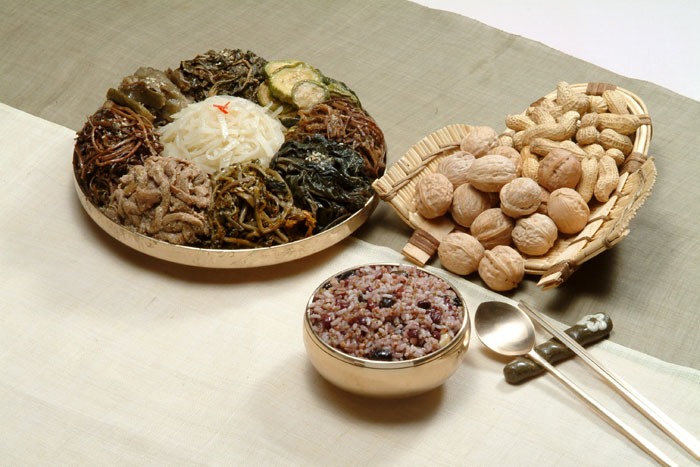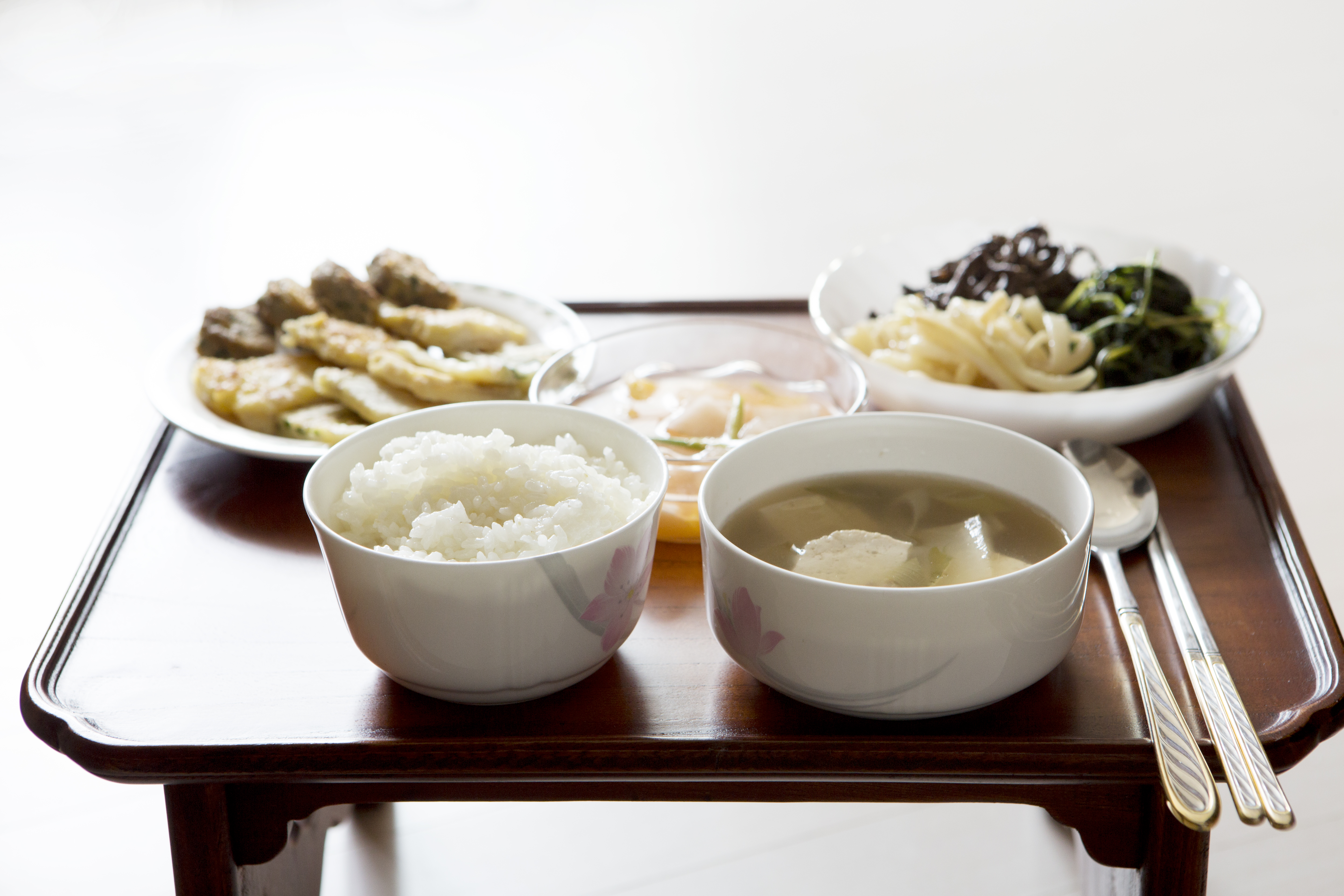|
Ogokbap
''Ogok-bap'' * () or five-grain rice is a ''bap'' made of glutinous rice mixed with proso millet, sorghum, black beans, and red beans. It is one of the most representative dishes of ''Daeboreum'', the first full moon of the year in the Korean lunar calendar. In the past, the custom of eating ''ogokbap'' with ''boreum-namul'' (vegetables) and '' bureom'' (nuts) on this day helped people replenish nutrients that have been lost during the winter months, when food was scarce. Today, ''ogokbap'' is still enjoyed by Koreans for its nutritional and health benefits. It is a common diet food, and an increasing number of people replace their daily white rice with ''ogokbap'', due to a rise in lifestyle diseases like high blood pressure, diabetes, and angina. See also * '' Chalbap'', made of glutinous rice mixed with red beans, chestnut, jujube, and black beans * '' Japgok-bap'', made of rice mixed with various grains * ''Kongbap ''Kongbap'' is a Korean dish consisting of wh ... [...More Info...] [...Related Items...] OR: [Wikipedia] [Google] [Baidu] |
Daeboreum
Daeboreum (대보름; literally "Great Full Moon") is a Korean holiday that celebrates the first full moon of the new year of the lunar Korean calendar which is the Korean version of the First Full Moon Festival. This holiday is accompanied by many traditions. Origins The record about the origin of Daeboreum is recorded in the book Samgungnyusa, Samguk-yusa (in Korean: 삼국유사), where it says that a crow led the 21st King of Silla, Soji of Silla, Soji to shoot the geomungo (a Korean instrument) case, which was actually where a monk and the royal concubine were committing adultery. After this happening, on the first day of the pig, rat and horse years, people had behaved prudently, and also the 15th of January was called 'Ohgiil' (in Korean: 오기일, in Hanja:烏忌日) and offered sacrifice to heaven this day. Also the origins of Daeboreum can be recognized by some customs listed in books, such as Samguk Sagi, Samguk-sagi (in Korean: 삼국사기) and Silla-bongi (in Kor ... [...More Info...] [...Related Items...] OR: [Wikipedia] [Google] [Baidu] |
Bureom
In Korea, bureom () is a collection of various kinds of nuts such as peanuts, walnuts, pine nuts, chestnuts, and gingko nuts. It is popular and traditional to eat during the Daeboreum (literally: "Great Full Moon"), a Korean holiday that celebrates the first full moon of the new year of the lunar Korean calendar. It is believed that cracking a nut in your mouth early in the morning on Daeboreum will help strengthen teeth, avoid allergies, prevent boils, and bring good luck for the coming year. See also *Daeboreum Daeboreum (대보름; literally "Great Full Moon") is a Korean holiday that celebrates the first full moon of the new year of the lunar Korean calendar which is the Korean version of the First Full Moon Festival. This holiday is accompanied by m ... References Korean folklore Korean New Year foods Korean cuisine {{korea-cuisine-stub ... [...More Info...] [...Related Items...] OR: [Wikipedia] [Google] [Baidu] |
Korea
Korea ( ko, 한국, or , ) is a peninsular region in East Asia. Since 1945, it has been divided at or near the 38th parallel, with North Korea (Democratic People's Republic of Korea) comprising its northern half and South Korea (Republic of Korea) comprising its southern half. Korea consists of the Korean Peninsula, Jeju Island, and several minor islands near the peninsula. The peninsula is bordered by China to the northwest and Russia to the northeast. It is separated from Japan to the east by the Korea Strait and the Sea of Japan (East Sea). During the first half of the 1st millennium, Korea was divided between three states, Goguryeo, Baekje, and Silla, together known as the Three Kingdoms of Korea. In the second half of the 1st millennium, Silla defeated and conquered Baekje and Goguryeo, leading to the "Unified Silla" period. Meanwhile, Balhae formed in the north, superseding former Goguryeo. Unified Silla eventually collapsed into three separate states due to ... [...More Info...] [...Related Items...] OR: [Wikipedia] [Google] [Baidu] |
Namul
Namul ( ko, 나물) refers to either a variety of edible grass or leaves or seasoned herbal dishes made of them. Wild greens are called ''san-namul'' (, "mountain namul"), and spring vegetables are called ''bom-namul'' (, "spring namul"). On the day of Daeboreum, the first full moon of the year, Koreans eat ''boreum-namul'' (, "full moon namul") with five-grain rice. It is believed that boreum namuls eaten in winter help one to withstand the heat of the summer to come. Preparation and serving For namul as a dish, virtually any type of vegetable, herb, or green can be used, and the ingredient includes roots, leaves, stems, seeds, sprouts, petals, and fruits. Some seaweeds and mushrooms, and even animal products such as beef tendons are also made into namuls. Although in most cases the vegetables (and non-vegetable namul ingredients) are blanched before being seasoned, the method of preparation can also vary; they may be served fresh (raw), boiled, fried, sautéed, fermente ... [...More Info...] [...Related Items...] OR: [Wikipedia] [Google] [Baidu] |
Jujube
Jujube (), sometimes jujuba, known by the scientific name ''Ziziphus jujuba'' and also called red date, Chinese date, and Chinese jujube, is a species in the genus ''Ziziphus'' in the buckthorn family Rhamnaceae. Description It is a small deciduous tree or shrub reaching a height of , usually with thorny branches. The leaves are shiny-green, ovate-acute, long and wide, with three conspicuous veins at the base, and a finely toothed margin. The flowers are small, wide, with five inconspicuous yellowish-green petals. The fruit is an edible oval drupe deep; when immature it is smooth-green, with the consistency and taste of an apple with lower acidity, maturing brown to purplish-black, and eventually wrinkled, looking like a small date. There is a single hard kernel, similar to an olive pit, containing two seeds. Chemistry Leaves contain saponin and ziziphin, which suppresses the ability to perceive sweet taste. Flavinoids found in the fruits include Kaempfero ... [...More Info...] [...Related Items...] OR: [Wikipedia] [Google] [Baidu] |
Castanea Crenata
''Castanea crenata'', the Japanese chestnut, also known as the Korean chestnut is a species of chestnut native to Japan and Korea. ''Castanea crenata'' exhibits resistance to ''Phytophthora cinnamomi'', the fungal pathogen that causes ink disease in several Castanea species. The mechanism of resistance of ''Castanea crenata'' to ''Phytophthora cinnamomi'' may derive from its expression of the Cast_Gnk2-like gene. Description ''Castanea crenata'' is a small to medium-sized deciduous tree growing to 10–15 m tall. The leaves are similar to those of the sweet chestnut, though usually a little smaller, 8–19 cm long and 3–5 cm broad. The flowers of both sexes are borne in 7–20 cm long, upright catkins, the male flowers in the upper part and female flowers in the lower part. They appear in summer, and by autumn, the female flowers develop into spiny cupules containing 3–7 brownish nuts that are shed during October. Cultivation and uses ''Castanea crenata'' is ... [...More Info...] [...Related Items...] OR: [Wikipedia] [Google] [Baidu] |
Angina Pectoris
Angina, also known as angina pectoris, is chest pain or pressure, usually caused by insufficient blood flow to the heart muscle (myocardium). It is most commonly a symptom of coronary artery disease. Angina is typically the result of obstruction or spasm of the arteries that supply blood to the heart muscle. The main mechanism of coronary artery obstruction is atherosclerosis as part of coronary artery disease. Other causes of angina include abnormal heart rhythms, heart failure and, less commonly, anemia. The term derives from the Latin ''angere'' ("to strangle") and ''pectus'' ("chest"), and can therefore be translated as "a strangling feeling in the chest". There is a weak relationship between severity of angina and degree of oxygen deprivation in the heart muscle, however, the severity of angina does not always match the degree of oxygen deprivation to the heart or the risk of a myocardial infarction (heart attack). Some people may experience severe pain even though the ... [...More Info...] [...Related Items...] OR: [Wikipedia] [Google] [Baidu] |
Diabetes Mellitus
Diabetes, also known as diabetes mellitus, is a group of metabolic disorders characterized by a high blood sugar level ( hyperglycemia) over a prolonged period of time. Symptoms often include frequent urination, increased thirst and increased appetite. If left untreated, diabetes can cause many health complications. Acute complications can include diabetic ketoacidosis, hyperosmolar hyperglycemic state, or death. Serious long-term complications include cardiovascular disease, stroke, chronic kidney disease, foot ulcers, damage to the nerves, damage to the eyes, and cognitive impairment. Diabetes is due to either the pancreas not producing enough insulin, or the cells of the body not responding properly to the insulin produced. Insulin is a hormone which is responsible for helping glucose from food get into cells to be used for energy. There are three main types of diabetes mellitus: * Type 1 diabetes results from failure of the pancreas to produce enough insulin due to lo ... [...More Info...] [...Related Items...] OR: [Wikipedia] [Google] [Baidu] |
Hypertension
Hypertension (HTN or HT), also known as high blood pressure (HBP), is a long-term medical condition in which the blood pressure in the arteries is persistently elevated. High blood pressure usually does not cause symptoms. Long-term high blood pressure, however, is a major risk factor for stroke, coronary artery disease, heart failure, atrial fibrillation, peripheral arterial disease, vision loss, chronic kidney disease, and dementia. Hypertension is a major cause of premature death worldwide. High blood pressure is classified as primary (essential) hypertension or secondary hypertension. About 90–95% of cases are primary, defined as high blood pressure due to nonspecific lifestyle and genetic factors. Lifestyle factors that increase the risk include excess salt in the diet, excess body weight, smoking, and alcohol use. The remaining 5–10% of cases are categorized as secondary high blood pressure, defined as high blood pressure due to an identifiable cause, such ... [...More Info...] [...Related Items...] OR: [Wikipedia] [Google] [Baidu] |
Lifestyle Disease
Lifestyle diseases can be defined as diseases linked with one's lifestyle. These diseases are non-communicable diseases. They are caused by lack of physical activity , unhealthy eating, alcohol, substance use disorders and smoking tobacco, which can lead to heart disease, stroke, obesity, type II diabetes and lung cancer. The diseases that appear to increase in frequency as countries become more industrialized and people live longer include Alzheimer's disease, arthritis, atherosclerosis, asthma, cancer, chronic liver disease or cirrhosis, chronic obstructive pulmonary disease, colitis, irritable bowel syndrome, type 2 diabetes, heart disease, hypertension, metabolic syndrome, chronic kidney failure, osteoporosis, PCOD, stroke, depression, obesity and vascular dementia. Lifestyle disease may soon have an impact on the workforce and the cost of health care. Treating these non-communicable diseases can be expensive. It can be critical for the patients health to receiv ... [...More Info...] [...Related Items...] OR: [Wikipedia] [Google] [Baidu] |




